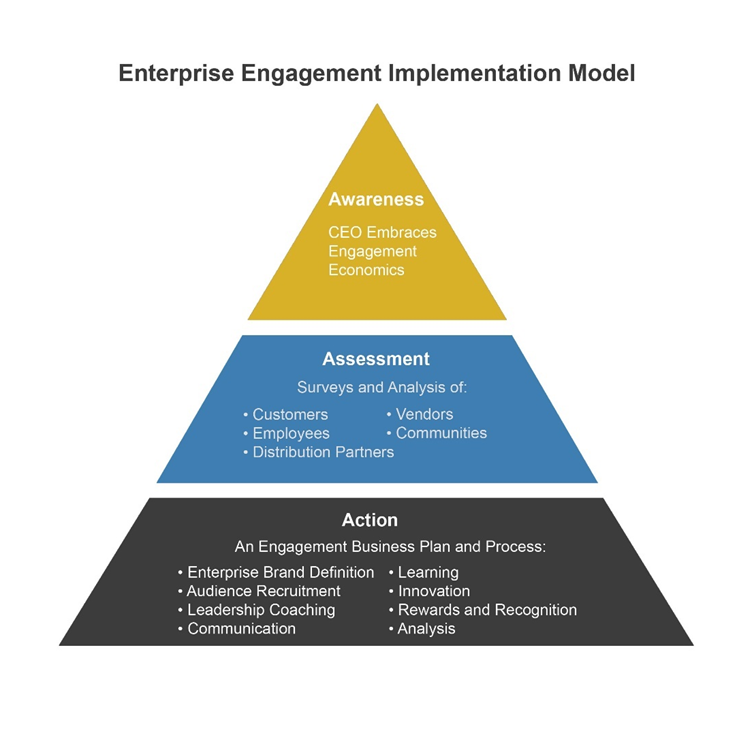How to Implement Enterprise Engagement
Sponsored by:

![]() Click here to download the PDF of this article.
Click here to download the PDF of this article.
With more pension funds and ESG (Environmental, Social, Governance) investors seeking to invest in companies that value human capital and engagement, the pressure grows on public companies to develop a formal engagement strategy and return-on-investment mechanism. The same pressure applies to any organization seeking a new competitive edge. The challenge, of course, is that the subject of Enterprise Engagement is not taught in business schools nor written about in the general media, so top management can be forgiven for having little knowledge of how to address key issues.
Founded in 2008, the Enterprise Engagement Alliance has as its mission to provide organizations with a formal roadmap so that they can take appropriate action, much like Six-Sigma, Total Quality Management, and other tools have accomplished for different aspects of organizational management.
The pyramid chart below demonstrates both the theoretical simplicity and major challenges of Enterprise Engagement implementation. Proposed by Joe Keller, President of MotivAction, and tweaked by the EEA curriculum team, the model shows what’s required for organizations to profit from engagement. (MotivAction is a leading performance improvement company that is benefiting from the growing demand for more actionable engagement services. See the recent ESM feature on MotivAction.)

This graphic depiction of the Enterprise Engagement implementation process identifies critical issues faced by proponents of this emerging field:
Top management support is critical. Simply put, Enterprise Engagement starts at the top. While managers can deploy engagement principles in their sales, marketing, human resources, operation and other management roles, an organizational approach can only begin when the CEO and/or the board understand the fundamental economics and the ongoing commitment involved.
Why engagement has not improved. Most companies have no strategic, ongoing assessment process covering all their audiences that gets strategically translated into a formal plan implemented across the organization. Skepticism about engagement is high in some circles precisely because organizations have collectively spent billions of dollars on surveys that rarely get the full attention they deserve. Very few of the leading consulting companies that create these surveys can provide a completely integrated solution in the manner that an advertising agency can implement integrated campaigns in the marketing field.
The challenge of silos. Most research, as well as common sense, suggests that fostering the proactive involvement of people in an organization’s mission requires a combination of factors: a clear mission, good management, audience recruitment, communications, learning, innovation, empowerment, rewards & recognition, analysis and more. Unfortunately, in most organizations many of these tactics remain separated by silos and lack of common mission. The integration that has occurred in marketing over the last decade has yet to occur in engagement or internal marketing.
The technology revolution. In the same way that Customer Relationship Management (CRM) technology and the Internet make it easier to better integrate the relationship process with customers, technology platforms based on the Engagement Portal make it possible for organizations of almost any size to build a one-on-one engagement platform seamlessly linked with CRM when appropriate. As with CRM, organizations already have a growing number of solutions from which to select, with many more are on the way. These technologies will make it possible for organizations to manage relationships with employees, distribution partners, vendors and communities on a one-to-one basis, just as they do with customers.
The market gap. A quick look at the pyramid chart quickly identifies the gap and opportunity for solution providers. Which companies can provide a completely integrated solution addressing all the key levers of engagement, from leadership and recruitment, assessment, communication, learning, rewards and recognition, analytics? Innovators at companies with formal engagement strategies piece together multiple major resources to manage an array of internal and external branding efforts. (See ESM, Hilton’s Brand VP: Enterprise Engagement is Happening), Management consulting companies often help clients deal with the results of assessments and surveys, but almost always in a specific area related to management coaching or training, rather than addressing all the other levers of engagement depicted in the chart.
Ironically, the companies that come closest to addressing the multiple audiences and tactics involved with engagement are traditional incentive companies that often work with sales, marketing and employee programs, as well as loyalty and recognition companies. While a few have profited from the engagement trend, most remain focused on selling their specific tactics as engagement tools rather than stepping back to address an overall integrated solution.
The emerging players. The horse-and-buggy companies did not embrace automobiles, nor did yellow taxi owners invent Uber. The truth is, companies are loath to disrupt themselves. That said, ESM has reported that a growing number are succeeding (See: Making the Shift to Engagement: Three Pioneers Share Their Experience). There are more examples to come from companies already set up to handle different types of programs, including branding, leadership, coaching, communications, learning, rewards & recognition, events and much more, but which haven’t awakened to the need for formal, integrated engagement solutions.
The coming roll-up. Mergers and acquisitions have already begun. As already reported in ESM, industry leaders Blackhawk Engagement and Sodexo have made multiple purchases, as well as Montreal-based Rideau. In addition, Aon Hewitt bought Modern Survey, Korn Ferry purchased Hay Group and the William Morris Agency recently purchased Fusion Marketing. The Performance Link, a Roanoke-based incentive company, was recently purchased by ABrandCompany.com. The implementation model shows the potential, as well as the challenges and opportunities, for an industry just beginning to take shape. Top management has begun to get it, there is an abundance of assessment tools. Now what is needed at most companies is a formal plan and implementation process.
This article is sponsored by:
Andy Bollwerk, Director of Sales
314-775-2505














